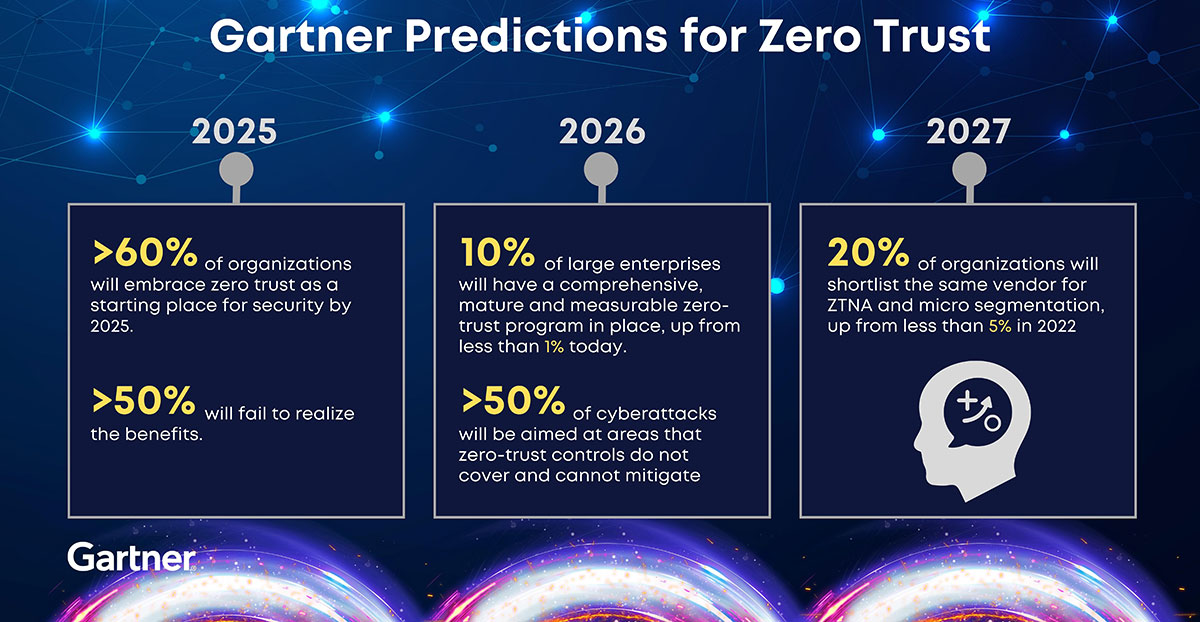Zero trust is top of mind for most organizations as a critical strategy to reduce risk, but few organizations have actually completed zero-trust implementations. Gartner, Inc. predicts that by 2026, 10% of large enterprises will have a mature and measurable zero-trust program in place, up from less than 1% today.
Gartner defines zero trust as a security paradigm that explicitly identifies users and devices and grants them just the right amount of access so the business can operate with minimal friction while risks are reduced.
“Many organizations established their infrastructure with implicit rather than explicit trust models to ease access and operations for workers and workloads. Attackers abuse this implicit trust in infrastructure to establish malware and then move laterally to achieve their objectives,” said John Watts, VP Analyst at Gartner. “Zero trust is a shift in thinking to address these threats by requiring continuously assessed, explicitly calculated and adaptive trust between users, devices, and resources.”
To help organizations complete the scope of their zero-trust implementations, it is critical that chief information security officers (CISOs) and risk management leaders start by developing an effective zero-trust strategy which balances the need for security with the need to run the business.
“It means starting with an organization’s strategy and defining a scope for zero-trust programs,” said Watts. “Once the strategy is defined, CISOs and risk management leaders must start with identity – it is foundational to zero trust. They also need to improve not only technology, but the people and processes to build and manage those identities.“However, CISOs and risk management leaders should not assume that zero trust will eliminate cyberthreats. Rather, zero trust reduces risk and limits impacts of an attack.”
Gartner analysts predict that through 2026, more than half of cyberattacks will be aimed at areas that zero- trust controls don’t cover and cannot mitigate.
“The enterprise attack surface is expanding faster and attackers will quickly consider pivoting and targeting assets and vulnerabilities outside of the scope of zero-trust architectures (ZTAs),” said Jeremy D’Hoinne, VP Analyst at Gartner.” This can take the form of scanning and exploiting of public-facing APIs or targeting employees through social engineering, bullying or exploiting flaws due to employees creating their own “bypass” to avoid stringent zero-trust policies.”
Gartner recommends that organizations implement zero trust to improve risk mitigation for the most critical assets first, as this is where the greatest return on risk mitigation will occur. However, zero trust does not solve all security needs. CISOs and risk management leaders must also run a continuous threat exposure management (CTEM) program to better inventory and optimize their exposure to threats beyond the scope of ZTA.
Zero Trust จัดเป็นกลยุทธ์ลดความเสี่ยงที่สำคัญที่สุดขององค์กรส่วนใหญ่ แต่มีองค์กรไม่กี่แห่งเท่านั้นที่ดำเนินการ Zero-Trust ได้สำเร็จ การ์ทเนอร์ อิงค์ คาดการณ์ว่าภายในปี 2569 ประมาณ 10% ขององค์กรขนาดใหญ่จะมีโปรแกรม Zero-Trust ที่ใช้ได้อย่างสมบูรณ์และวัดผลได้ เพิ่มขึ้นจาก ณ ปัจจุบันที่มีไม่ถึง 1%
การ์ทเนอร์ให้คำจำกัดความของ Zero Trust ว่าเป็นกระบวนการด้านความปลอดภัยที่สามารถระบุผู้ใช้และอุปกรณ์ได้อย่างชัดเจน พร้อมยังให้สิทธิ์การเข้าถึงในขอบเขตที่เหมาะสม เพื่อให้ธุรกิจสามารถดำเนินการได้โดยลดแรงเสียดทานให้น้อยที่สุดและมีความเสี่ยงต่าง ๆ ลดลง
จอห์น วัตส์ รองประธานฝ่ายวิจัยของ การ์ทเนอร์ กล่าวว่า “หลายองค์กรติดตั้งโครงสร้างพื้นฐานด้วยโมเดลความปลอดภัยที่คลุมเครือแทนที่จะเลือกใช้โมเดลที่มีความชัดเจน เพื่อให้การเข้าถึงและการดำเนินงานสำหรับพนักงานและตัวงานได้ง่าย ซึ่งแฮกเกอร์จะใช้จุดนี้เพื่อติดตั้งมัลแวร์ จากนั้นขยายวงการโจมตีให้กว้างขึ้นเพื่อให้บรรลุเป้าหมายที่วางไว้ Zero-Trust คือการเปลี่ยนแปลงแนวคิดสำหรับจัดการกับภัยคุกคามเหล่านี้ โดยอาศัยการประเมินอย่างต่อเนื่อง การคำนวณที่ชัดเจน และการกำหนดระดับความไว้วางใจที่ปรับเปลี่ยนได้ (Adaptive Trust) ระหว่างผู้ใช้ อุปกรณ์ และทรัพยากร”
ผู้บริหารด้านความปลอดภัยข้อมูล (หรือ CISO) และผู้นำด้านการบริหารความเสี่ยงจำเป็นอย่างยิ่งต้องเริ่มพัฒนากลยุทธ์ Zero-Trust ที่มีประสิทธิภาพ พร้อมสร้างสมดุลระหว่างความต้องการด้านความปลอดภัยกับความจำเป็นการดำเนินธุรกิจเพื่อช่วยให้องค์กรดำเนินการตามขอบเขตการใช้งาน Zero-Trust ได้อย่างสมบูรณ์แบบ
“นั่นหมายถึงการเริ่มต้นด้วยการสร้างกลยุทธ์ขององค์กร พร้อมกำหนดขอบเขตของโปรแกรม Zero-Trust เมื่อมีการกำหนดกลยุทธ์ดังกล่าวพร้อมแล้ว ผู้บริหาร CISO และผู้นำด้านการบริหารความเสี่ยงขององค์กรจะต้องเริ่มด้วยการระบุตัวตน ซึ่งเป็นพื้นฐานของ Zero-Trust และนอกเหนือจากการปรับปรุงทางด้านเทคโนโลยีแล้ว ยังหมายรวมถึงด้านบุคลากรและกระบวนการในการสร้างโปรแกรมการจัดการข้อมูลประจำตัวเหล่านั้นด้วย” วัตส์กล่าวเพิ่มเติม
“อย่างไรก็ตาม ผู้บริหาร CISO และผู้นำด้านการบริหารความเสี่ยง ไม่ควรคิดไปเองว่า Zero-Trust จะช่วยขจัดภัยคุกคามทางไซเบอร์ให้หมดสิ้นไป แต่ Zero-Trust ช่วยลดความเสี่ยงและจำกัดวงผลกระทบของการโจมตีได้”
นักวิเคราะห์ของการ์ทเนอร์ คาดการณ์ว่าจนถึงปี 2569 การโจมตีทางไซเบอร์มากกว่าครึ่งจะมุ่งไปยังเป้าหมายที่มาตรการรักษาความปลอดภัย Zero-Trust ยังไม่ครอบคลุมและเข้าไปช่วยบรรเทาความเสี่ยงไม่ได้
เจเรมี่ เดอฮูน รองประธานฝ่ายวิจัยของการ์ทเนอร์ กล่าวว่า “พื้นที่การถูกโจมตีขององค์กรกำลังขยายตัวอย่างรวดเร็ว และมุ่งไปที่สินทรัพย์และช่องโหว่ที่อยู่นอกขอบเขตของสถาปัตยกรรม Zero-Trust (ZTAs) โดยมันสามารถมาในรูปแบบของงานสแกนและใช้ประโยชน์จากช่องทางการพัฒนา APIs ที่เปิดแบบสาธารณะหรือการพุ่งเป้าไปยังพนักงานโดยผ่านเทคนิคการหลอกลวงให้เหยื่อเปิดเผยข้อมูล (Social Engineering) การกลั่นแกล้งหรือใช้ประโยชน์จากข้อบกพร่องเนื่องจาก “ช่องทางลัด” ที่พนักงานเป็นผู้สร้างเอง เพื่อหลบเลี่ยงมาตรการความปลอดภัยของ Zero-Trust ที่เข้มงวด”
การ์ทเนอร์แนะนำองค์กรธุรกิจให้หันมาปรับใช้แนวทาง Zero-Trust เพื่อลดความเสี่ยงในสินทรัพย์ที่มีความเปราะบางเป็นลำดับแรก เนื่องจากเป็นจุดสำคัญสุดที่จะเกิดความเสี่ยง อย่างไรก็ตามแนวทาง Zero Trust ไม่ได้ช่วยแก้ปัญหาความต้องการด้านความปลอดภัยทั้งหมด ผู้บริหาร CISO และผู้นำด้านการบริหารความเสี่ยงยังต้องใช้โปรแกรม Continuous Threat Exposure Management (CTEM) เพื่อปรับปรุงรายการทรัพย์สิน พร้อมปรับระดับการเปิดช่องให้การคุกคามใด ๆ ที่อยู่นอกขอบเขตของ ZTA
